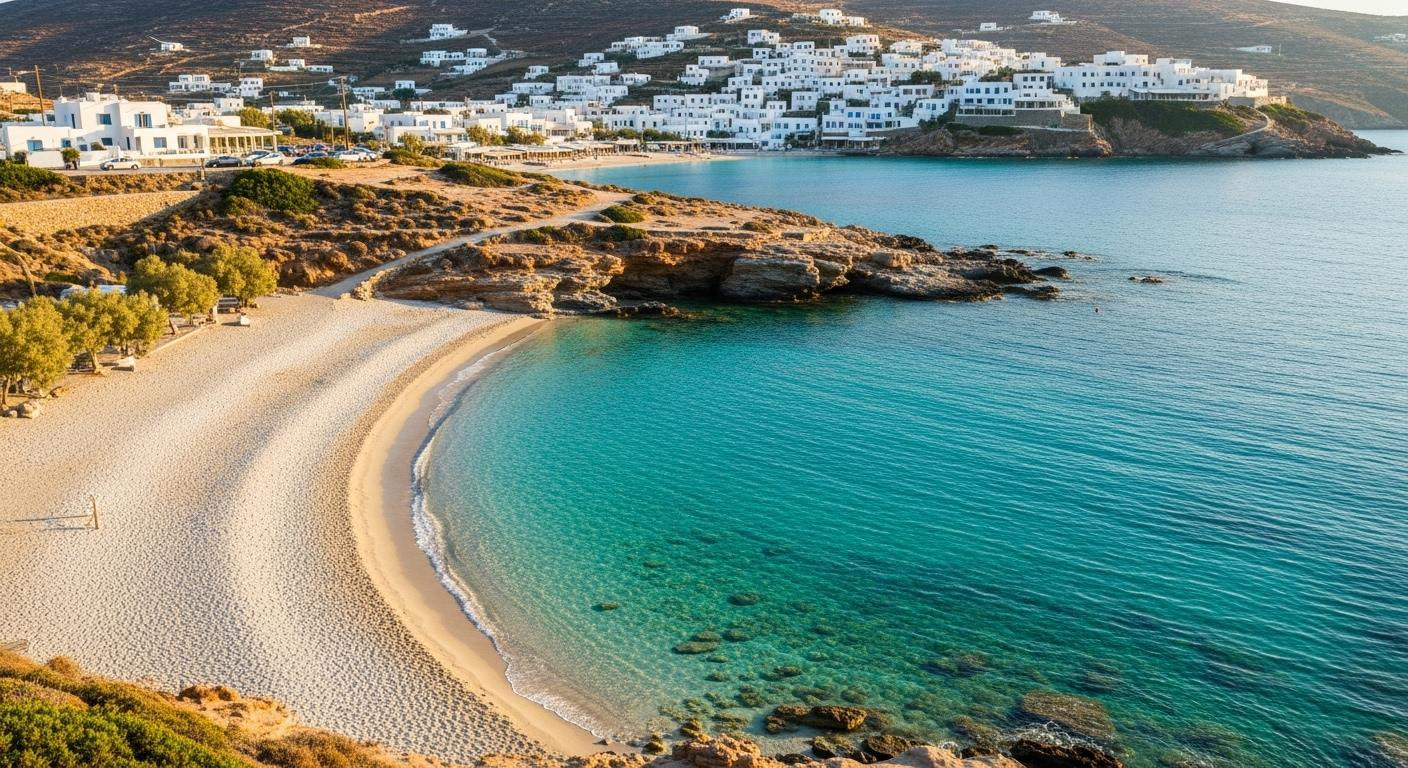Golden light filters across Kedros Beach at dawn, revealing nothing but pristine sand and turquoise water stretching toward Naxos. The silence feels profound, broken only by gentle waves lapping the shore. Three fishing boats bob in the harbor of Agios Stavros, where fewer than 200 residents guard one of the Aegean’s last authentic secrets.
Donoussa floats quietly in the Small Cyclades, a 5.3-square-mile sanctuary where one unpaved road connects three untouched beaches. Ferry access requires 5-6 hours from Athens or 1-2 hours from Naxos, naturally filtering out day-trippers and cruise crowds. This geographic isolation has preserved what Santorini lost decades ago.
Where one road connects everything that matters
The island’s single main road threads through villages that feel suspended in time. No gas station exists here. One taxi serves the entire population of 213 permanent residents, according to the 2021 Greek census.
Bus service runs only June through August, connecting the harbor village of Stavros to settlements like Kalotaritissa and Haravgi. November brings a different rhythm: residents walk everywhere, and visitors discover the meditative pace of island life.
Ferry schedules reflect this intentional simplicity. Blue Star Ferries operates limited winter routes from Piraeus, while SeaJets connects through Naxos on reduced schedules. These remote islands maintain warm waters through November while tourist infrastructure deliberately stays minimal.
The island time forgot to commercialize
Cycladic architecture without tour groups
Whitewashed houses cascade down hillsides in pure Cycladic tradition. Blue-domed churches dot landscapes where goats outnumber tourists by substantial margins. The architecture mirrors Santorini’s postcard perfection, but without selfie crowds or $18 cocktails.
Locals inhabit these structures as family homes passed through generations, not boutique hotels. Stone walls follow Byzantine patterns, unmarked by commercial signage or tourist infrastructure.
Where mythology meets archaeological reality
The island honors Dionysus, who according to local legend established a hidden sanctuary here after rescuing Ariadne from Naxos. Archaeological evidence confirms Neolithic settlements dating to 3000 BC in the Mersini area.
This isn’t manufactured heritage tourism but continuity of culture stretching millennia. Athens remains the gateway for ferry connections to these ancient island traditions.
Three beaches, zero crowds
Kedros, Livadi and Stavros beaches
Kedros Beach stretches 600 feet of soft sand and crystal water. Arrive at sunrise and claim total solitude for hours. The 15-minute walk from the main road rewards early risers with Instagram-worthy scenes minus the crowds.
Livadi Beach hides in a secluded cove, requiring a moderate 40-minute hike from Stavros harbor. Rolling waves and complete privacy justify the effort. Stavros Beach sits steps from the ferry dock, offering convenient swimming for the handful of November visitors.
Grilled octopus and morning markets
Weekly Thursday markets showcase local produce, cheese and herbs from 9:00 AM to 1:00 PM in Agios Stavros central square. Vendors arrive with donkey carts, creating scenes unchanged for generations.
Tavernas serve octopus caught that morning, fresh seafood priced for locals ($17-30 per meal), and vegetables grown in island gardens. Small communities like this protect authentic dining experiences tourists often miss.
What Santorini cost before Instagram
Accommodation runs $50-66 for basic rooms, $88-132 for apartments. These prices represent 68% savings compared to Santorini, 45% less than Naxos for equivalent stays.
The real luxury here exists in temporal terms: claiming Kedros Beach three hours before anyone else arrives, watching sunrise paint whitewashed walls gold, experiencing Cycladic islands before 2.1 million annual tourists discovered them. Island destinations maintaining warmth through November offer similar off-season authenticity.
Your questions about this remote island with 1 road and 3 beaches feels lost in time, Donoussa, Greece answered
How do you actually get there?
Fly to Athens International Airport, then ferry from Piraeus port (5-6 hours) or connect through Naxos (1-2 hours). Blue Star Ferries and SeaJets operate seasonal routes, but schedules vary significantly. No airport exists on Donoussa, maintaining its isolation.
When should you visit for the best experience?
May-June and September-October deliver 68-77°F temperatures, warm swimming conditions, and minimal crowds. November offers 57-68°F days, 65°F water temperatures, and empty beaches for solitude seekers. July-August brings heat and the island’s brief tourist season.
How does it compare to other Cycladic islands?
Donoussa offers identical Cycladic architecture and similar turquoise waters as Santorini, but with one-hundredth the tourists and half the costs. Santorini provides luxury infrastructure while Donoussa delivers authentic island rhythm. Choose based on whether you prioritize services or silence.
The last ferry departs at 4:00 PM, its wake the only disturbance on glassy harbor water. Afternoon light transforms limestone cliffs to amber while a local fisherman mends nets in centuries-old silence. This remains Greece before the world arrived.
